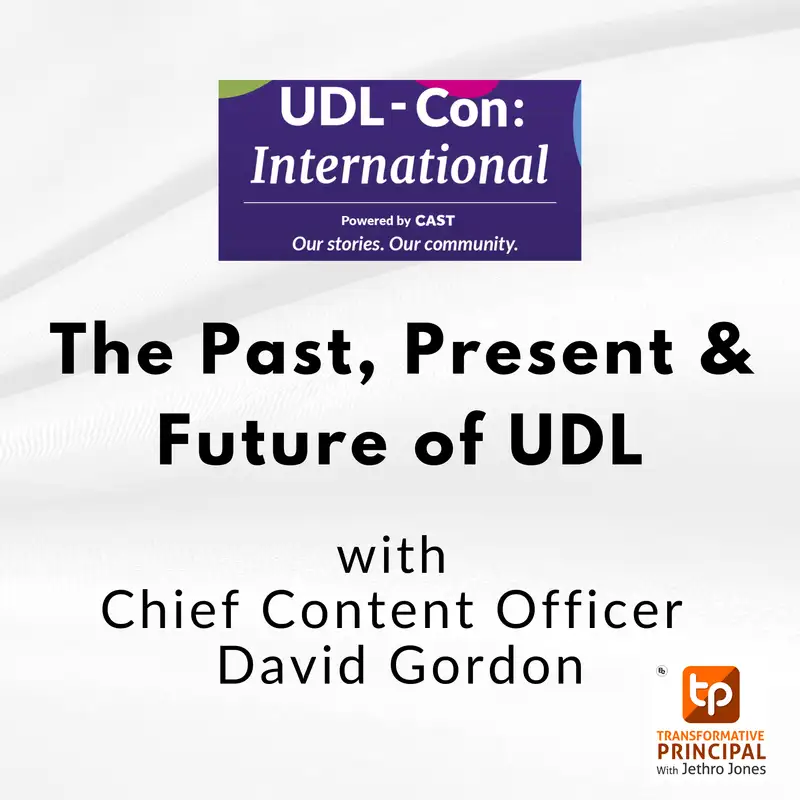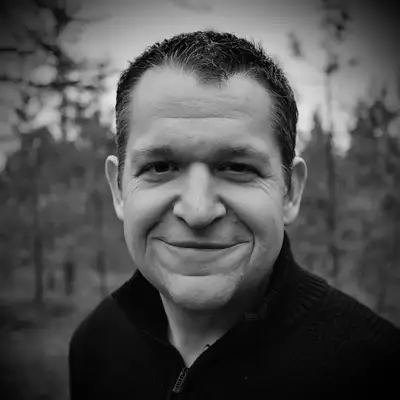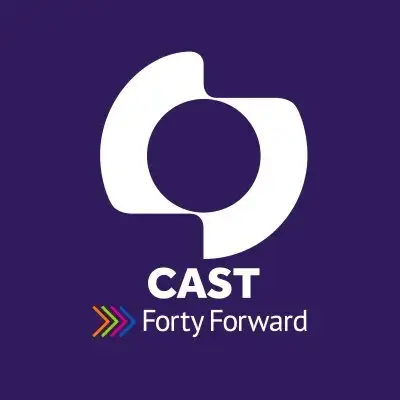The Past, Present & Future of UDL with Chief Content Officer David Gordon #udlcon
Download MP3David Gordon
===
[00:00:00] Welcome to Transformative Principle. I am here live for this episode at the CAST UDL Con International Conference, and here we are talking about all things related to Universal Design for learning, which is a way to make it so that learning is accessible to all students. This has been a great conference
so far, the one you're listening to right now is from the UDL Conference. And really a great time. Check out cast.org for information about UDL. UDL-Con and so much more.
Okay, welcome to this special episode of Transformative Principle. We are here at the cast UDL Con, which is a conference put on by cast and you can get more information about@cast.org. They released [00:01:00] the new 3.0 guidelines, uh, today. Very exciting stuff. I'm here with David Gordon, who's the chief Content Officer of cast.
And so you've been at the company, uh, for 20 years, and when you started, you were celebrating the 20th anniversary and looking forward to what the future could be. We're now celebrating the 40th year. Uh, how good were you all at predicting the future and what has surprised you?
Yeah. Well, that's a great question.
I would say, um, we've not been great at predicting the future. I think we could not have imagined. Yeah. Um, how much UDL would grow both here in the United States and all over the world. Mm-Hmm. Um, at the time that, uh, we celebrated our 20th anniversary, uh, UDL was, uh, still very aspirational. We were still working out.
We had the three principles, uh, that our co-founders, David Rose and Ann [00:02:00] Meyer had laid out in their. Uh, book teaching every student in the digital Age. Yeah. Uh, this was back when we still talked about the digital age because it was something new. It wasn't a given, it wasn't part necessarily of everyone's everyday life, which it now is.
Yeah. Uh, technology was still, uh, a novelty in some respects. Uh, there were great hopes for what technology could do in terms of, uh. Improving, uh, accessibility, inclusivity in education. But, and as a quick side note, do
you feel like that that technology has lived up to the promise, or do you feel like it sells a long way to go?
Well,
I think there's always a long way to go, but I think also we, we hadn't envisioned the iPhone at that point. Right. Um, the, um, so the iPhone was still three years away and, um. Just the remarkable access that those [00:03:00] kinds of tools have brought with Built-in accessibility supports. Yeah. So of course there's still a lot you need to do to know where those supports are and know how to use them, right?
So simply having access to supports like that doesn't guarantee that they'll be used or used in an effective way. And of course, there. It is a lot of technology that still is really lagging behind in terms of, uh, universal accessibility and universal design. But at that time, uh, there was still a lot of, um, expectation that technology would play a, um, a big role.
In closing, any number of gaps in education achievement. Um, but we had the principles. We did not have guidelines yet, although, uh, uh, the team led by, um, Dr. David Rose, our co-founder was working, a [00:04:00] small team, was working on the. First edition of the guidelines, which eventually would come out in 2008. And, uh, that was, uh, a multi-year process of, of getting those written and what the guidelines did.
What, what guidelines 1.0 achieved for cast. I think was really giving, uh, the field a powerful tool for concrete implementation of this aspirational and visionary, uh, inclusive framework called Universal Design for Learning. So we had our three principles, uh, provide multiple means of representation, multiple means of action and expression.
Uh, and perhaps most importantly, multiple means of engagement. Mm-Hmm. Uh, but what that looked like in practice, uh, was up [00:05:00] for great debate. Yeah. Yeah. Um, another interesting point is that at the time, uh, that we were celebrating 20 years, there were other competing models. Of UDL still in the field. Um, cast had coined the term, had laid down these principles based on, uh, neuroscience and best practices in education and a lot of experience going back a century.
Yeah. Uh, and the accrued and, uh, and applied knowledge, uh, that we had access to. But there were other organizations, other groups out there that were saying, well, UDL is not that. It's really based on the architectural principles of universal design or so. One of the things the guidelines enabled us to do, uh, was really establish, [00:06:00] um, uh, a kind of common language for practitioners to have a common set of agreements about what UDL.
Might look like in practice. Yeah. Not perfect. That's why we're now on 3.0. Right. And not still on 1.0 because there's always a need to improve. Um, at one point when we came out with the 2.0 guidelines, three years later in 2011, uh, we had taken a lot of input from practitioners who said, you know, that.
The way you're talking about it, there isn't quite right. Maybe it should say this, maybe it should say that. And again, David Rose and his team went back, checked the research, everything was, uh, predicated on um, good research foundations and, um, made those updates. Then a few years later. 2014 when we, um, put out a second [00:07:00] book about Universal Design for Learning called UDL Theory In practice written again by doctors, uh, David Rose and Ann Meyer.
we made another adjustment to the guidelines, which was to, Change the order of how the principles were represented. We put engagement first mm-Hmm. As a way of really emphasizing the importance of engagement and learning. We didn't want anyone to think there was a hierarchy, right? Of representation, expression, and engagement.
Uh, but rather that, um, engagement was, um. in some ways, uh, really important to focus on to, you know, get kids and adults at this point because we were really focusing on adult learning at that point as well, um, to get them a brought into the learning experience. And then you can also deal with representation and action.
Yeah. [00:08:00] So, um, all of which is a, a long way of saying that. it was in the last 20 years that, uh, the really sophisticated implementation of Universal Design for Learning was made possible, both by advances in technology, but I think more importantly in hindsight Yeah. By the development of these guidelines and, um, yeah.
Yeah. Well,
and, and I appreciate that so much because the guidelines are not something that you have to. Buy or pay for, or that you have to be specifically trained on. Yes, there is training available, but anybody can look at those and say, what am I doing to engage students? What am I doing to represent learning or represent opportunities for them?
What am I doing, uh, to, and then the last one just left me some on the spot, but yeah, what, what am I doing as a teacher to help with this? And that is, that is how I came to approach it. And I was like. [00:09:00] Oh, these are great because this gives me a framework and a way to point to somebody else and say, these people also say that what I'm doing here is worthwhile.
And so like for me personally, the, the engagement, I call that enrollment rather than engagement because kids have to choose themselves to enroll in the learning process or adults do too, and. You can be engaged but not be learning anything. And you can be engaged, but not by choice. You can just happen to be in that position and therefore you're, you're doing that.
And, and I think that this way of being able to give people a framework for what that looks like is incredibly powerful because it gives credence to a lot of things that seem like common sense, but are actually. Grounded in research and we know beneficial.
Yes. And it's, uh, really a gift that keeps on giving.
So yes, you can look at the graphic organizer of the guidelines and um, [00:10:00] that's a great place to start. And if you want to go deeper, you can go to udl guidelines.cast.org. Yeah. And there are, uh, there's a wealth of resources. There are examples of what these different, uh, guidelines look like in practice.
There are extensive, um, research citations underpinning each one. So if you are wondering, you know, is this legit? What are the origins of this suggestion? You know, uh, then you can explore those, uh. Um, research, uh, and evidence-based, uh, articles, uh, on your own and, uh, make up your own mind. But it's all there.
Yeah, there's, it's, um, it's all, uh, written and presented in a scientific way and, uh, the backup is there if you really want to explore [00:11:00] it on your own. And then. 10 years ago, what we did was we created, uh, cast professional publishing, and at the time we launched with this second, uh, textbook I told you about, universal Design for Learning Theory and Practice.
But then we opened up an invitation to the field, uh, to practitioners, uh, to thought leaders in the field. To, and we offered them a platform through our publishing house Yeah. To share the, the, the many ways in which they were using the guidelines, the way they were implementing the, uh, UDL framework. And, uh, today we, uh, we've had a modest publishing program.
We've done, you know, four or five books a year. We now have, uh, about four dozen books and products after 10 years. And, uh, they cover the gambit from, [00:12:00] uh, the whole spectrum from, um, early childhood, uh, right up through adult learning. Uh, there are, uh, some of them, uh, take UDL and, and blend it with other frameworks.
Which is also a wonderful entree into UDL where you see UDL as complimentary to maybe something you're already doing. And so that's been very, very gratifying, uh, to, uh, and that's been my, most of my daily work for the last 10 years has been in publishing and it's been very gratifying to work with so many great.
Uh, practitioners in the field who are teaching us Mm-Hmm. What UDL looks like, what works, what doesn't work. Yeah. And giving voice to them. So, um, and, and to be clear,
those, those people are not, uh, those authors are not cast employees. No necessarily. Although you may have some,
but they're not. Yeah, one or two [00:13:00] maybe.
Uh, but usually in partnership with someone outside of Tess. Yeah, but they are all from, um, some of them from colleges and universities, right. Where they teach, uh, pre-service or in-service teachers. Some are. Uh, former educators who, uh, former day-to-Day educators who are now, uh, professional educators, you know, consultants and, uh, providing professional learning.
Um, we have administrators, et cetera, and, yeah.
Well, and it's a, it's a different approach 'cause a lot of companies would say, oh, we need to make sure this is all in-house. We don't want to let the, the secret out or whatever. And, and you've been very open. With that and what is the reasoning behind that for why you've made those decisions?
Yeah. Well, uh, we are, uh, primarily, uh, an, uh, a nonprofit, uh, education organization that really is committed to creating a world where [00:14:00] learning has no limits. That's our tagline. Yeah. Where learning until learning has no limits. Yeah. And, um, I think our founders, uh, David Rose and Ann Meyer, one of the, uh, principals, they really, uh, it, uh, sat down early on 40 years ago when they started the organization, was that, uh, partnership is important, that going it alone.
In education or, you know, in most of life is, uh, not a recipe for success. It's not a recipe for growing your knowledge or wisdom that, uh, there's great benefit in crowdsourcing wisdom and research and experience. And that our, uh, you know, and a recognition that universal design for learning. In the end is just a means to an end.
The end is this world where, uh, there are [00:15:00] no barriers to learning for anyone. Uh, and if UDL is no longer helpful in achieving that end. Okay, let's get rid of it. Yeah. Wow. But so far, so good. Yeah, it's so far been helpful. And now with the 3.0 guidelines, even more so because we've expanded our understanding and recognition of the many barriers that can arise in a typical learning environment and, uh, addressed those.
Yeah. Very good. Uh, this was awesome. Thank you so much for your time. I'm delighted for sharing. I think we could probably talk for hours. We could You get me started? I could keep going. I, I could see that we just barely scratched the surface, so, we'll, we'll have to connect again later and do a longer sit down.
Well,
uh, Jethro, it's delightful to talk to you and I'm so glad you're here in Sacramento with cast and, and with this beautiful field of people.
Yeah, agreed. Thank you so much. [00:16:00] Appreciate it. Okay. Thank you.
Yep.
Creators and Guests



